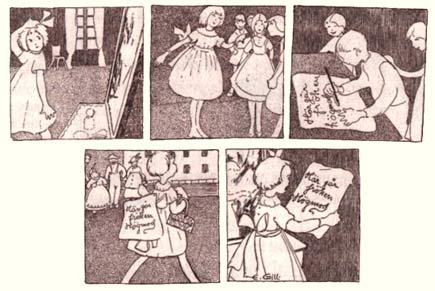'Lillans Morgongröt' (Folksolans Barntidning, 1924)
Ester Johanna Gill was born with last name 'Petterson', but the whole family added 'Gill' around 1917. She got polio when she was 3 years old and after that she was unable to use her body from the waist and down, unless with use of a scaffold. Due to her handicap, she lived with the care of her family for most of her life. She spent the final years of her life in a hospital.
She got her artistic education with Althin's painting school and The Royal Academy of Free Arts in Stockholm from 1918 to 1921. She mostly painted landscapes and she ran her own art school in Malmö from 1921 to 1924. She drew comic strips for Folkskolans Barntidning from 1918 to 1926, including 'Lillans Morgongröt' (1924) and 'Den Egenkära Gunilla' (1928). Gill went on to draw 'Sara' cartoons for children in the Stockholm based newspaper Dagens Nyheter between 1925 and 1939. She also had commissions for the big printing concern Bonniers and for some other smaller printers.
'Den Egenkära Gunilla' (Folksolans Barntidning, 1928)
A relative of Ester Gill sent Lambiek the following description of Ester Gill's life:
"Ester Johanna Gill was born Petterson, but the whole family added Gill around 1917. The name Gill is said to emanate from believed ancestors from Wallonia (Belgium) during the 17th century when Sweden imported thousands of competent artisans within the mining industry. She got polio when she was 3 years old and was after that unable to use her body from the waist and down. During childhood her younger sister Inger pushed or pulled her around in a small cart. Later on Ester had to live long periods in Vanföreanstalten (the institution for handicapped persons), an institution that those who were forced to live there say were very severe, very unfriendly, more like a hospital than a home or a school, although many lived there the year around for many years. In Vanföreanstalten she got a heavy metal rack or scaffold with the weight of 14 kg. Inside this scaffold her body hang in straps. She had the full use of her upper body so this scaffold reached to her armpits. When she walked she used two sticks to "throw" first one fake metal leg (with her own leg dangling inside) forward and then the other. She did not use a rolling chair until late in life. In this heavy way she managed all the stairs inside Konstakademin, and all other stairs in normal life in Stockholm. When she entered a tram wagon she had to sit on the dirty steps and heave her body up, step by step. It was heartrending to see how much strength she had to use for one little step forward. She could not bend those metal legs so she always sat with the metal legs stretched out from chairs, with the heavy black boots that ended the metal legs coming out under the hem of her – always very long – frocks. There are few photos of Ester Gill as she loathed her own appearance. She was meant to be a beautiful woman, but her shoulders were pushed up as she always had to hang on the sticks with her arms. Her family had to sell Långö bruk in the beginning of the 1910s only to see it closed down. The central product was scythes which were exported to both Russia and America. Before this economical catastrophy the family had had a typical bourgoise life style, but after they had to leave Långö bruk the family was very poor. With the help of former customers, her father eventually got a job as seller with an iron monger. All the children had to go to work immediately. The exceptions were Ester Gill and her younger brother Olle Gill. Ester Gill got a full artists education starting with Althin's painting school and completed in The Royal Academy of Free Arts in Stockholm from 1918 to 1921. She used tempera, oil and water colors for her paintings which very often depicted landscapes. Ester Gill probably wanted to be a full time painter like her younger brother Olle Gill, but fate was against this as she had to get some income.
And as it was difficult for her to live alone in a flat, she moved to her parents in Malmö after finishing Konstakademin. There she ran her own art school in Malmö 1921-24. Typical for Ester Gill's life is that this school was placed on the second or third floor. Her father died in Malmö in the beginning of the 1920s and then the family moved to Stockholm. She drew the strips for Folkskolans barntidning 1918-26, but her mother Isabella Gill concocted and wrote the stories. Ester Gill went on to draw cartoons for children in the big Stockholm based newspaper Dagens Nyheter 1925-39. She also had commissions for the big printing concern Bonniers and for some other smaller printers. Sometime, probably between the two world wars, Ester Gill planned to start an art school in St. Petersburg in Russia. It seems realistic to believe that she planned this together with some friends. The plans never got implemented, perhaps because of World War II. Ester Gill lived first with her mother, and then for decades with her younger sister, but also with other relatives in her last decade. The very last years she lived in a hospital as no relative was strong enough to raise her, with her heavy scaffold, if she fell on the floor.



